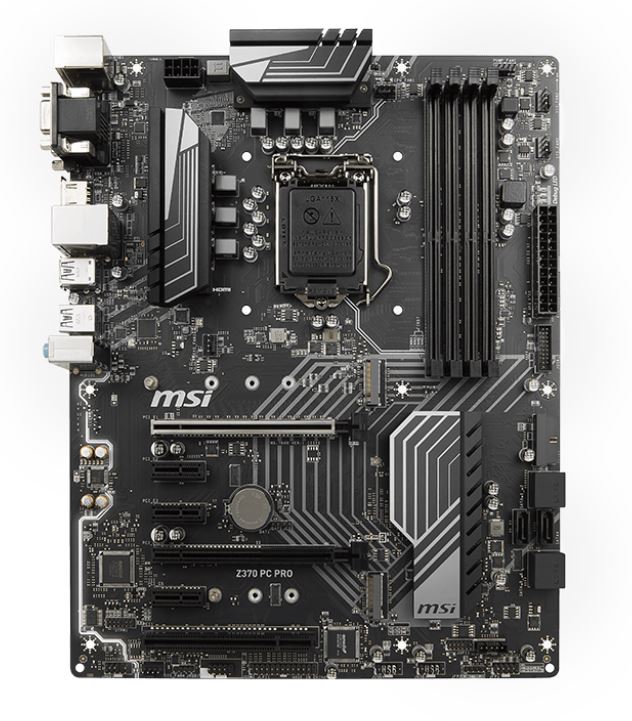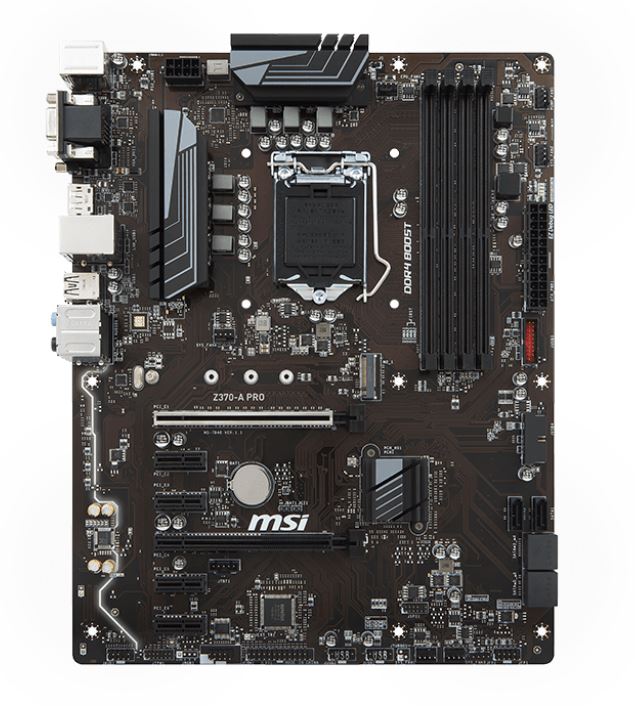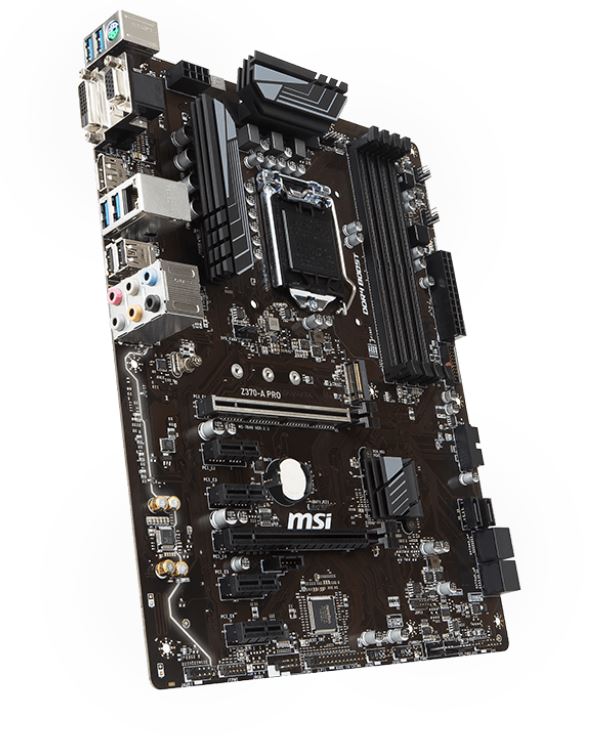Analyzing Z370 for Intel's 8th Generation Coffee Lake: A Quick Look at 50+ Motherboards
by Ian Cutress, Anton Shilov, Joe Shields & Gavin Bonshor on October 20, 2017 2:00 PM ESTMSI Z370 PC Pro and MSI Z370-A Pro
The Pro series consists of two motherboards, the Z370 PC Pro and Z370-A Pro. Both boards use the same six-phase power delivery found in the Gaming Plus. Outside of storage, USB, PCIe support, and the aesthetic differences, both Pro boards keep similar specifications.
The PC Pro goes with a jet black PCB with a silver pattern focused around the chipset heatsink. That same pattern makes its way on the black VRM heatsinks. All the slots and connectors are black with the only reinforced slot being the primary PCIe. Except for the audio separation line, all the RGB LEDs are found on the back of the board creating a glow behind the motherboard. The PC Pro does offer a single RGB header for connecting an RGB strip, enhancing the existing lights.
The Z370-A Pro, on the other hand, is more of a plain brown board with the only patterns on it being the hundreds of visible traces snaking from part to part. The VRM heatsinks, memory slots, and PCIe slots are all black. Like its bigger brother, the first slot is reinforced. The Z370-A Pro uses all white LEDs (no other colors) on the back as well as the audio line. To some users rejoicing, there are no RGB headers on this board.


Z370 PC Pro (left), Z370-A Pro (right)
Memory support on both of the boards is the same, with four memory slots up to 64GB and supported speeds up to DDR4-4000. Both boards have two full-length PCIe slots, the first one being reinforced and x16 from the processor with the second not being reinforced and x4 from the chipset. Where the Z370-A Pro has four PCIe x1 slots, the PC Pro replaces one of them and adds a legacy PCI slot at the bottom.
The Z370-A Pro and PC Pro make the full set of six SATA ports available to users, with four regular placed ports and two vertical, although the layout of where they are is slightly different. The Z370-A Pro has the vertical SATA ports above the other four, while the PC Pro slides the vertical ports between the other four, due to the support of other features.
Fan header count and location are the same on both boards with six 4-pin connectors around the board, four of which are around the chipset. All of these headers support both PWM and voltage control for greater flexibility. For audio and networking, the PC Pro has the ALC887 and Intel I219-V, while the Z370-A Pro has the ALC892 and Realtek TRL8111H. Both boards use Capicon audio caps, and the audio traces are separated from the other portions of the board in an effort to reduce interference.


Z370 PC Pro (left), Z370-A Pro (right)
The PC Pro offers users USB 3.1 (10 Gbps) capabilities through the ASM3142 chipset and offers one Type-C port and one Type-A port on the back panel, while the Z370-A Pro does not offer 10 Gbps support. Both boards offer four eight USB 3.1 (5 Gbps) Type-A ports and two USB 2.0 ports on the back panel. Both boards have a combination PS/2 connector, video outputs, Ethernet, and an audio stack, although the PC Pro uses a HDMI and 2.1 audio, while the Z370-A Pro uses DisplayPort and 7.1 audio. Both boards have D-Sub and DVI-D connectors.
| MSI Z370 PC Pro and A Pro | ||
| Warranty Period | 3 Years | |
| Product Page | Link | Link |
| Size | ATX | |
| CPU Interface | LGA1151 | |
| Chipset | Intel Z370 Express | |
| Memory Slots (DDR4) | Four DDR4 Supporting 64GB Dual Channel Support DDR4 4133+ |
|
| Network Connectivity | 1 x Intel I219-V | 1 x Realtek RTL8111H |
| Onboard Audio | Realtek ALC887 | Realtek ALC892 |
| PCIe (CPU) | 2 x PCIe 3.0 x16 slots @ x16 / x4 | |
| PCIe (PCH) | 1 x PCIe 3.0 x4 3 x PCIe 3.0 x1 |
1 x PCIe 3.0 x4 4 x PCIe 3.0 x1 |
| SATA | 6 x Supporting RAID 0/1/5/10 | |
| Onboard SATA Express | None | |
| Onboard M.2 | 2 x PCIe 3.0 x4 or SATA | 1 x PCIe 3.0 x4 or SATA |
| Onboard U.2 | None | |
| USB 3.1 (10 Gbps) | 1 x Type-C (ASMedia) 1 x Type-A (ASMedia) |
None |
| USB 3.1 (5 Gbps) | 4 x Rear Panel 2 x Headers |
|
| USB 2.0 | 2 x Rear Panel 2 x Headers |
|
| Power Connectors | 1 x 24-pin EATX 1 x 8-pin ATX 12V |
|
| Fan Headers | 1 x 4-pin CPU 1 x 4-pin Waterpump 4 x 4-pin System Fan (All PWM or Voltage controlled) |
|
| IO Panel | 1 x PS/2 keyboard/mouse 1 x VGA port 1 x DVI-D port 1 x HCMI Port 1 x LAN (RJ45) port 4 x USB 3.1 Gen 1 ports 1 x USB 3.1 Gen 2 Type-A 1 x USB 3.1 Gen 2 Type-C 2 x USB 2.0 Type A Audio Jacks |
1 x PS/2 keyboard/mouse 1 x VGA port 1 x DVI-D port 1 x DisplayPort 1 x LAN (RJ45) port 4 x USB 3.1 Gen 1 Type A 2 x USB 2.0 ports Audio Jacks |












83 Comments
View All Comments
weevilone - Wednesday, October 25, 2017 - link
Notable that though the new boards are often very similar to their Z270 predecessors, Asus has dropped Thunderbolt 3 support from the Maximus X Hero board.masouth - Thursday, October 26, 2017 - link
ASUS ROG Z370 Maximus X Hero"....new metallic heat sinks that are an upgrade over the plastic heatsinks found on the Z270 version"
Please excuse my ignorance because I didn't own a ROG Z270 mb but...plastic HEAT SINKS? Not shrouds or decoration over a heat sink but the actual heat sinks themselves? That's either wrong, they performed their job pretty poorly, or plastic resins have advanced a lot farther in thermal conductivity (and cost for such) than I realized.
flowrush - Sunday, November 19, 2017 - link
"The other main distinguishable feature is the inclusion of integrated 802.11ac Wi-Fi with an antenna (that can only be described as a shark fin) found on the F."The above is incorrect in the article. The integrated Wi-Fi module with antenna is found on the E not the F.
Coldgame - Saturday, November 25, 2017 - link
I'm looking to build a rig with the Z370 Gaming ITX/ac, a GTX-1070 card and an Apple Thunderbolt Display.The review states:
"The key difference in the support between the two boards is going to be the Thunderbolt 3 port on the Gaming-ITX. This port supports video outputs..."
So, can anyone confirm or deny that video generated by the GTX-1070 can be output through the onboard Thunderbolt 3 port?
hanselltc - Sunday, December 3, 2017 - link
Looking forward to low-middle end mITX choices from this platform. It'll probably be paired with a 8100/8300 and be my secondary machine.Roen - Sunday, February 4, 2018 - link
Where are the 10 Gbps ports on the back? They all look like 5 Gbps ports, even the Type C.rbarak - Wednesday, February 21, 2018 - link
Is anyone using the Z370-P on Linux with two screens?I built a new machine based on the Z370-P, and both the DVI and the HDMI connected screens show the same image, and the RHEL7 setup/displays show only one Unknown Display.
I follwed the advice on stackexchange, and added this line:
$ grep GRUB_CMDLINE_LINE_DEFAULT /etc/default/grub
GRUB_CMDLINE_LINE_DEFAULT="i915.alpha_support=1"
Then I did:
sudo grub2-mkconfig -o "$(readlink /etc/grub2.conf)"
And rebooted, but still, the two displays are not shown.
dromoxen - Wednesday, May 9, 2018 - link
Shocked to see that both the Asrock mitx boards are "szie=ATX" .. LOLThe addition of Tunderbolt sure seems to add a hefty premium £120 vs £160 , luckily I can do without.
Kroebo - Sunday, October 7, 2018 - link
Sadly, I discovered that the ZUG Gaming PLUS doesn't support SLI.trag - Tuesday, January 15, 2019 - link
On the ASrock Z370M Pro4 the M.2 slot information is backwards. Both slots support NVME. One slot also supports SATA. As written, "The first M.2 slot is SATA only while the second supports PCIe." it seems to say that one slot is SATA only and the other slot is PCIe (NVME) only.